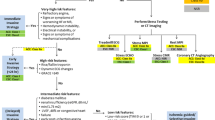Abstract
In September 2014, the 2014 AHA/ACC Guideline for the Management of Patients with Non-ST-Elevation Acute Coronary Syndromes (NSTE-ACS) was released electronically; it was published in print 3 months later, in December 2014. The management of NSTE-ACS has evolved significantly in recent years, and a number of novel agents are now available for use (e.g., prasugrel, ticagrelor). In addition, several key diagnostic and therapeutic agents that were formerly considered hallmarks in the treatment of acute coronary syndrome have fallen out of favor (e.g., glycoprotein inhibitors, CK-MB). The 2014 AHA/ACC NSTE-ACS guideline document is the first comprehensive publication for the treatment of non-ST-elevation acute coronary syndromes since 2007; this review paper serves as an overview of the 2014 NSTE-ACS guideline, with emphasis on several paramount changes since the 2007 version.
Similar content being viewed by others
References
Amsterdam EA. AHA/ACC guideline for the management of patients with non-ST-elevation acute coronary syndromes. Circulation. 2014;130:e344–426.
Go AS. Heart disease and stroke statistics—2014 update. Circulation. 2014;129(3):e28–e292.
Yeh RW. Population trends in the incidence and outcomes of acute myocardial infarction. NEJM. 2010;362(23):2155–65.
Antman E. The TIMI risk score for unstable angina/non–ST elevation MI. JAMA. 2000;284(7):835–42.
Thygesen K. Third universal definition of myocardial infarction. JACC. 2012;60(16):1581–98.
Anderson J. ACC/AHA 2007 guidelines for the management of patients with unstable angina/non-ST-elevation myocardial infarction. JACC. 2007;50(7):e1–e157.
Newby LK. Frequency and clinical implications of discordant creatine kinase-MB and troponin measurements in acute coronary syndromes. JACC. 2006;47(2):312–8.
Volz K. Creatine kinase-MB does not add additional benefit to a negative troponin in the evaluation of chest pain. Am J Emerg Med. 2012;30(1):188–90.
Volz K. Should creatine kinase-MB index be eliminated in patients with indeterminate troponins in the ED. Am J Emerg Med. 2012;30(8):1574–6.
Meine T. Association of intravenous morphine use and outcomes in acute coronary syndromes: results from the CRUSADE Quality Improvement Initiative. Am Heart J. 2005;149(6):1043–9.
Becker R. Bleeding complications with the P2Y12 receptor antagonists clopidogrel and ticagrelor in the PLATelet inhibition and patient Outcomes (PLATO) trial. Eur Heart J. 2011;32(23):2933–44.
Wallentin L. Ticagrelor versus clopidogrel in patients with acute coronary syndromes. NEJM. 2009;361(11):1045–57.
Montalescot G. Pretreatment with prasugrel in non-ST-segment elevation acute coronary syndromes. NEJM. 2013;369(11):999–1010.
Wiviott S. Prasugrel versus clopidogrel in patients with acute coronary syndromes. NEJM. 2007;357(20):2001–15.
Stone G. Routine upstream initiation vs deferred selective use of glycoprotein IIb/IIIa inhibitors in acute coronary syndromes: the ACUITY Timing trial. JAMA. 2007;297(6):591–602.
Giugliano R. Early versus delayed, provisional eptifibatide in acute coronary syndromes. NEJM. 2009;360(21):2176–90.
Smith S. AHA/ACCF secondary prevention and risk reduction therapy for patients with coronary and other atherosclerotic vascular disease – 2011 update. JACC. 2011;58(23):2432–46.
Author information
Authors and Affiliations
Corresponding authors
Ethics declarations
Conflict of Interest
Dr. Howard and Dr. Wenger have no relevant disclosures.
Human and Animal Rights and Informed Consent
This article does not contain any studies with human or animal subjects performed by the author.
Additional information
This article is a part of Topical Collection on Women and Heart Disease
Rights and permissions
About this article
Cite this article
Howard, B.G., Wenger, N.K. Review of the 2014 AHA/ACC Guideline for the Management of Patients with Non-ST-Elevation Acute Coronary Syndromes: What is New and Why?. Curr Cardiovasc Risk Rep 10, 17 (2016). https://doi.org/10.1007/s12170-016-0496-3
Published:
DOI: https://doi.org/10.1007/s12170-016-0496-3




